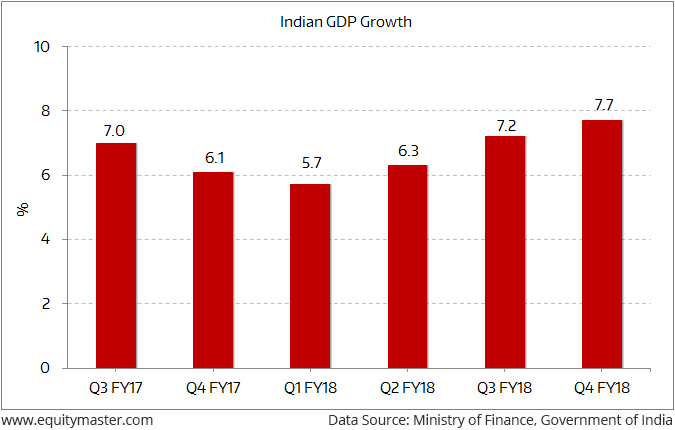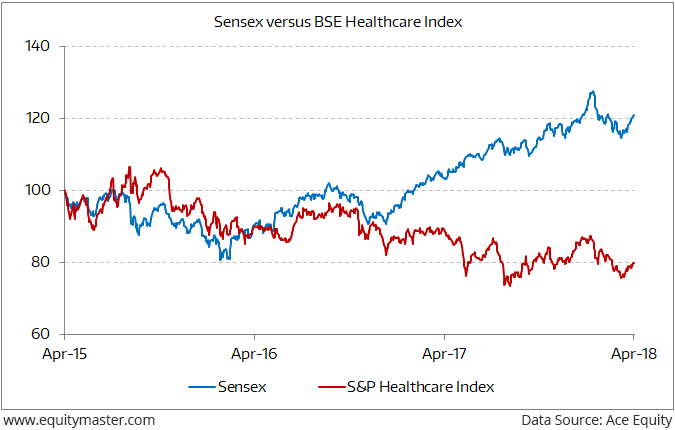Asian share markets are mixed today as Japanese and Hong Kong shares rise. The Nikkei 225 is up 0.2% while the Hang Seng is up 0.1%. The Shanghai Composite is trading down by 0.5%.
Back home, India share markets opened the day on a positive note. The BSE Sensex is trading higher by 100 points while the NSE Nifty is trading up by 23 points. The BSE Mid Cap index and BSE Small Cap index both opened the day down by 0.1% & 0.2% respectively.
Sectoral indices have opened the day on a mixed note with metal stocks and stocks in the IT sector witnessing buying interest. While, power stocks & energy stocks have opened the day in red. The rupee is trading at 67.26 to the US$.
In news about the economy, India's GDP grew by a strong 7.7% in the fourth quarter of FY18. This is the fastest growth since the demonetisation saga back in November 2016.
Despite a robust growth in the quarter, for the full year 2017-18, GDP growth fell to 6.7%, the lowest in the four years of the current government is set to release the GDP numbers for the quarter, and full year today. Ahead of the official numbers, global ratings agency, Moody's downgraded its forecast for the country. India's GDP is set to grow by 7.3% in 2018, according to a Moody's report, a cut from its previous forecast of 7.5%. However, it maintained its 7.5% growth forecast for 2019.
According to the global ratings major, despite the moderation in March, industrial production growth averaged 6.2% in the January-March period, up from 5.9% in the previous quarter.
The report states that growth should benefit from an acceleration in rural consumption, supported by higher minimum support prices and a normal monsoon.
The private investment cycle will continue to make a gradual recovery, as twin balance-sheet issues -- impaired assets at banks and corporates -- slowly get addressed through deleveraging and the application of the Insolvency and Bankruptcy Code.
The official numbers beat most estimates as the agriculture, manufacturing and construction sectors the bedrock of the economy, all witnessed robust growth in the fourth quarter.
The Indian economy grew 6.6% in the last fiscal as it battled the lingering effects of demonetisation in 2016. Teething issues related to implementation of GST, which hampered operations of small and medium sized enterprises and exporters, also contributed to growth moderation.
GDP Growth Getting Back on Track

India's economy seems to have gotten its steam back, now with consistent GDP growth above the 7% mark.
The growth rate for 2017-18 was higher than the government's first and second advance estimates - at 6.5% and 6.6%- and in sync with what the International Monetary Fund, the World Bank and the Economic Survey had estimated. This is the last piece of macroeconomic data before the Reserve Bank of India reviews the monetary policy in June.
Notably, with strong GDP numbers this quarter, India has retained the fastest growing economy tag, surpassing China.
0.4% while the CAC 40 was down by 0.5%
In news from stocks in the aviation sector. The government's attempt to sell a stake in Air India drew a blank again, after it did not receive any bids for the national carrier. Notably, the stake sale did not receive any bids even after extending the deadline twice.
Government hopes to call for fresh bids in the next couple of weeks, after the matter is taken up by the Administrative Mechanism (AM), comprising the Ministers of Finance, Civil Aviation and Roads.
The intention is to complete the sale of a 76% stake in the airline before the end of the financial year.
The government on 1 May extended the privatization process of Air India by a fortnight and clarified various knotty issues identified by potential bidders.
Notably, Jet Airways ruled out a bid for debt-laden national carrier Air India citing unfavorable terms of the offer.
The announcement came just days after rival IndiGo pulled out of the race to acquire Air India's operations meaning the government now has no clear frontrunner in the sale campaign.
Once the country's monopoly airline, Air India has slowly lost market share to new low-cost private players in one of the world's fastest-growing airline markets.
Air travel has recorded double-digit growth for 40 consecutive months, thanks to low fares, the addition of new flights/destinations, and overall growth in the economy.
What's foreseeable for India's aviation traffic in 2018 is some pressure on the back of the consistent rise in crude oil prices. Earlier this month, Brent crude oil briefly breached US$80 per barrel and touched its highest level since December 2014. Crude prices have been driven up by production curbs in OPEC nations and Russia, as well as by robust demand on the back of healthy global economic growth.
Oil prices are closely monitored by the Indian air carriers, as aviation turbine fuel is their single largest input cost. A sharp rise in the cost of fuel puts pressure on margins, and consequently an increase in air fares.
Although air travel is becoming the new normal, investors need to understand the industry dynamics before buying up aviation stocks.
This article was originally published in English at www.equitymaster.com
Read the complete Indian stock market update. For the terms of use, go here.

